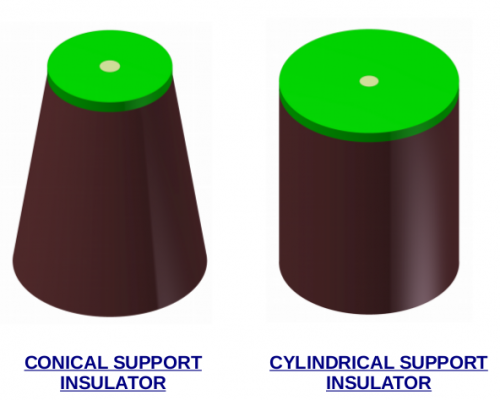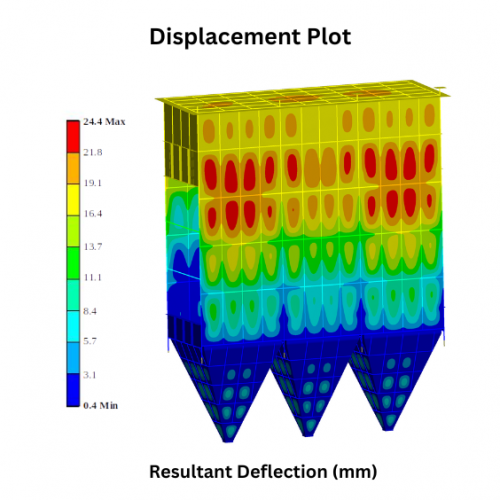INTRODUCTION
To guarantee optimal performance and reliability of power plant equipment, it is crucial to consider the fluctuating thermal and mechanical loading during operation. TEFUGEN provides FEA solutions for various areas of thermal power plants, in addition to other domains, to choose reliable and optimally designed structural components of various equipment and systems deployed in power plants.
Air-Preheater Diaphragm Plate: Prediction of Thermal Deflection
The Air-Preheater (APH) in a thermal power plant is subjected to thermal deflection of its diaphragm plates due to the temperature gradient, which increases clearance between the seals and sector plate, leading to heavy leakage from the air to the gas side due to differential pressure. To accurately predict the deflection and set the APH seals to minimize leakage, FEA is used to simulate the thermal gradient and its effects on the diaphragm plates during operation, which helps in the optimal seal setting required for reducing the effective gaps of air leakage.
Air-PreHeater Bearing Housing – Prediction of Stress & Deformation due to loading
The APH Bearing Housing is a crucial component that bears the weight of the entire APH and is subject to various loads during operation. Excessive deflection in the bearing outer race seating area of the housing, caused by both weight and operation loads, can significantly reduce the bearing’s lifespan. Therefore, FEA simulations are used to predict stresses and deflection in the housing, ensuring that they are within acceptable limits prior to the design and manufacturing of a full APH. Such simulations are particularly useful during renovation and modernization projects at power plants.
Stress and deflection predictions for pressure vessels
Pressure vessels are designed to hold gases under high pressure, but due to the operating conditions and fluctuations in pressure and temperature, fatigue cracks can be initiated at the points of discontinuity where the fatigue strength is weakened. These points are often the areas of highest stress in the vessel. FEA is a valuable tool for evaluating local failure and fatigue in pressure vessels and can also be used to determine the location of stress classification lines at structural discontinuities.
Thermo-Mechanical Analysis of ESP Support Insulators
ESP Support Insulators made of special ceramics serve to insulate the electrodes at 50KV-150KV DC from the ESP housing, while also supporting the collecting electrode. These insulators operate at a high temperature of 400°C. Using FEA, the structural stability of both conical and cylindrical shaped insulators was analyzed, and it was found that the stress produced in the conical insulator was higher than in the cylindrical insulator. Therefore, it was concluded that cylindrical insulators are a better choice than conical insulators for ESP support applications.

Thermo-Mechanical Analysis of ESP Support Insulators
ESP Support insulators made of special ceramics serve to insulate the electrodes at 50KV-150KV DC from the ESP housing, while also supporting the collecting electrode. These insulators operate at a high temperature of 400°C. Using FEA, the structural stability of both conical and cylindrical shaped insulators was analyzed, and it was found that the stress produced in the conical insulator was higher than in the cylindrical insulator. Therefore, it was concluded that cylindrical insulators are a better choice than conical insulators for ESP support applications.
Thermo Mechanical Analysis of Expanded Metal Screens (EMS)
To ensure the effectiveness and durability of the Erosion Control Device (ECD), which is used to mitigate flow induced erosion of boiler pressure parts used in coal fired thermal power plants, FEA is carried out to evaluate its structural stability under high operating temperature and velocity conditions. FEA helps to ensure that the ECD can withstand the harsh operating environment and prevent unplanned shutdowns due to tube punctures caused by erosion.

Thermo Mechanical Analysis of the APH Center Section
To ensure the structural integrity of the Air Preheater (APH), the center section, which divides the air and flue gas side, needs to be designed with sufficient strength. Finite Element Analysis (FEA) is used to predict the stress and deformation of the center section under varying thermal and mechanical loading conditions. This helps in optimizing the design to ensure that the center section can withstand the operating conditions of the APH with minimal structural weight.

Stress Analysis of the APH Bearing Housing
The bearing housing of an Air Preheater is responsible for supporting the weight of the entire unit and enduring both axial and radial loads during operation. If the deformation of the outer race seating area of the bearing housing exceeds 0.03mm, it can result in a reduced bearing lifespan. To avoid this, FEA is employed to evaluate the stress and deformation levels in the housing at the design stage itself prior to manufacturing, making it a valuable and cost saving tool for power plant renovation and modernization projects.


Thermo Mechanical Analysis of Electrostatic Precipitator Casing
The casing of an Electrostatic Precipitator is typically constructed with mild steel plates, reinforced with necessary stiffeners, to withstand various loads such as horizontal winds, earthquakes, internal components, and ash. Additionally, the casing must also withstand a minimum thermal load of 150°C. To efficiently handle the complex design and analysis of such large structures, Finite Element Analysis (FEA) is an excellent tool that offers fast and accurate solutions through advanced mathematical computations.


Thermo Mechanical Analysis of APH Rotor Assembly
Due to the temperature gradient within the Air Preheater (APH), thermal deflection is an inevitable occurrence in the rotor modules, resulting in a gap between the sector plate and diaphragm plates. This gap causes air and flue gas leakage, which can be mitigated by implementing seals and other mechanisms. To accurately calculate the turn-down and related phenomena, Finite Element Analysis (FEA) can be utilized through coupled thermal-structural analysis. This approach can identify the extent of deflection-induced gaps and help in determining the sealing area required to minimize leakage.

